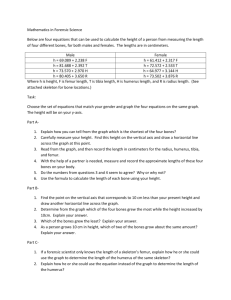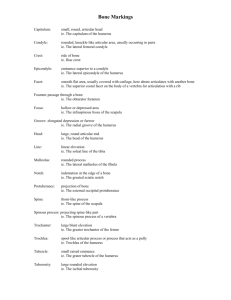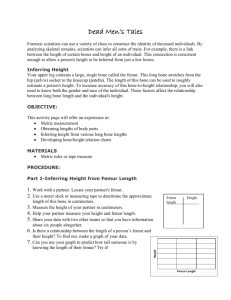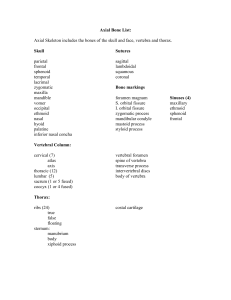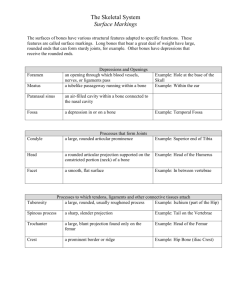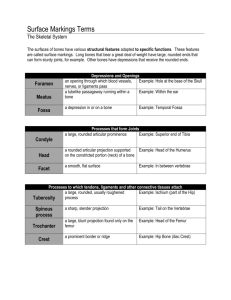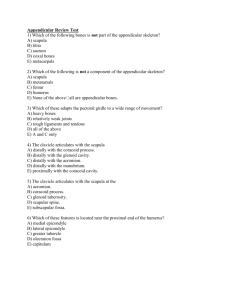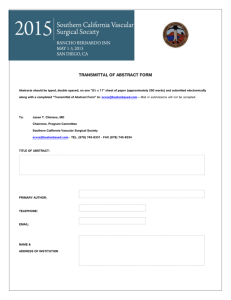Bones Tell Your Height
advertisement
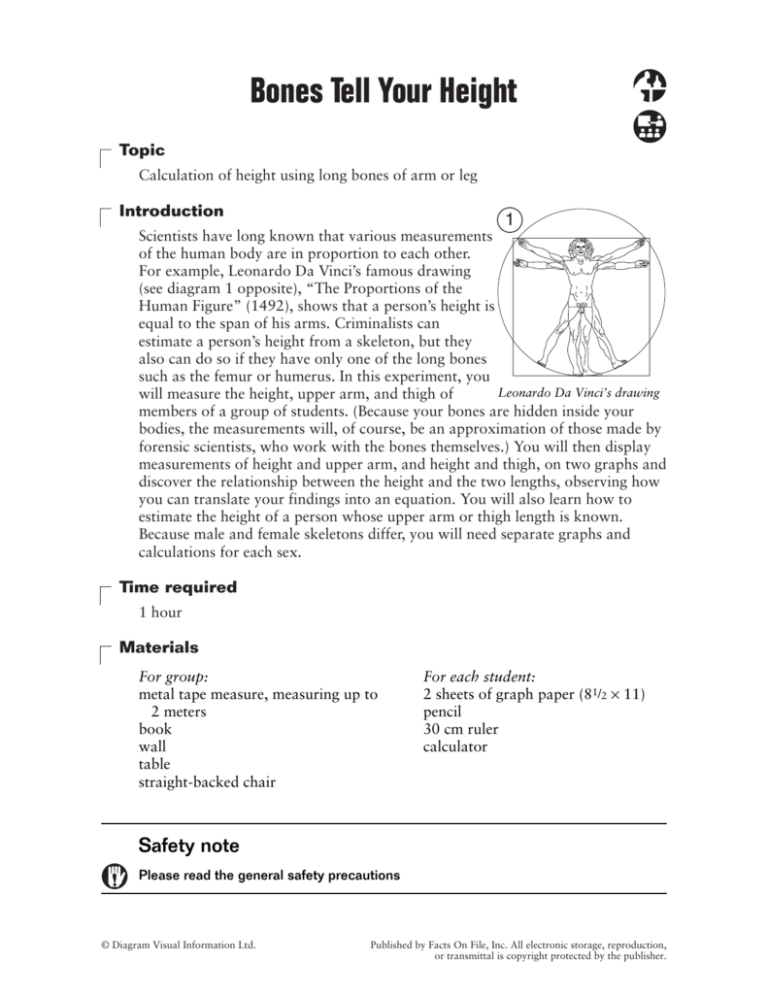
Bones Tell Your Height Topic Calculation of height using long bones of arm or leg Introduction 1 Scientists have long known that various measurements of the human body are in proportion to each other. For example, Leonardo Da Vinci’s famous drawing (see diagram 1 opposite), “The Proportions of the Human Figure” (1492), shows that a person’s height is equal to the span of his arms. Criminalists can estimate a person’s height from a skeleton, but they also can do so if they have only one of the long bones such as the femur or humerus. In this experiment, you Leonardo Da Vinci’s drawing will measure the height, upper arm, and thigh of members of a group of students. (Because your bones are hidden inside your bodies, the measurements will, of course, be an approximation of those made by forensic scientists, who work with the bones themselves.) You will then display measurements of height and upper arm, and height and thigh, on two graphs and discover the relationship between the height and the two lengths, observing how you can translate your findings into an equation. You will also learn how to estimate the height of a person whose upper arm or thigh length is known. Because male and female skeletons differ, you will need separate graphs and calculations for each sex. Time required 1 hour Materials For group: metal tape measure, measuring up to 2 meters book wall table straight-backed chair For each student: 2 sheets of graph paper (81/2 × 11) pencil 30 cm ruler calculator Safety note Please read the general safety precautions © Diagram Visual Information Ltd. Published by Facts On File, Inc. All electronic storage, reproduction, or transmittal is copyright protected by the publisher. Procedure This experiment works best with students who have reached adult height and requires a group of ten students of the same sex. Each member of the group is measured in turn by one of the other group members. The person being measured is referred to as A and the measurer as B. Table 1. Measurement methods* Height Stand in bare feet flat on the ground against a wall. Measure from the top of the head to the floor. height Upper arm (humerus) Place book on the top of the shoulder and the forearm flat on a table. Measure the distance between the lower side of the book and the top surface of the table. humerus Thigh (femur) Sit on a straight-backed chair with the spine against the chair back. Measure the distance between the chair back and the knee. femur *All measurements should be made in centimeters. 1. Measure the height of the first person using the method given in Table 1 above. Record this value in the first row of the data table on the next page. 2. Find the upper arm length of the first person using the method given in Table 1. Record this value in the data table. 3. Find the thigh length of the first person using the method given in Table 1. Record this value in the data table. 4. Repeat steps 1 to 3 for the other members of the group. 5. Give all members of the groups a copy of the results in the data table before proceeding with step 6. © Diagram Visual Information Ltd. Published by Facts On File, Inc. All electronic storage, reproduction, or transmittal is copyright protected by the publisher. 6. Work out a suitable scale and plot a graph of height against length of humerus for the group. 7. Consider the graph carefully and draw a straight line that marks the best representation of the points (i.e., the line of best fit). 8. Repeat steps 6 and 7, but this time plot a graph of height against length of femur for the group. DATA TABLE Is this a male or female group? Person Height in cm Upper arm length (humerus) in cm Thigh length (femur) in cm 1 2 3 4 5 6 7 8 9 10 Analysis 1. Where does the line cut the vertical axis on your graph of height against length of humerus? What is the gradient of the line of best fit? To find the gradient of a line of best fit through the points on a scatter graph such as this, take two points on the line whose coordinates are given by x1,y1 and x2,y2. The gradient (m) of the line is given by the formula: m = y2 – y1 x2 – x1 2. Where does the line cut the vertical axis on your graph of height against length of femur? What is the gradient of the line of best fit? 3. How would you expect your results to compare with those from a group of students of the opposite sex? 4. How could you use your findings to estimate the height of a body from which you have either a humerus or a femur? Want to know more? See Section 10: Our Findings © Diagram Visual Information Ltd. Published by Facts On File, Inc. All electronic storage, reproduction, or transmittal is copyright protected by the publisher. Sternum Breast bone Vertebral column Spinal column Height (cm) 8.03 Bones Tell Your Height 220 200 180 160 140 120 100 80 60 40 20 0 x2, y2 x1, y1 Y 0 10 20 30 Bone length (cm) 40 50 Our graph of height against length of humerus 1. Results will vary depending on the members of the group. Our graph of heights plotted against length of humerus looked like the one in the diagram above. In this graph, the line cuts the vertical axis at point Y. (Expect this to be around 70 cm.) You can calculate the gradient of the line of best fit (m) using the formula: m = y2 – y1 x2 – x1 In our example, x1 = 10, y1 = 100, x2 = 30, and y2 = 158. m = 158 – 100 30 – 10 m = 58 20 m = 2.9 © Diagram Visual Information Ltd. Published by Facts On File, Inc. All electronic storage, reproduction, or transmittal is copyright protected by the publisher. FORENSIC SCIENCE EXPERIMENTS ON FILETM OUR FINDINGS • 10.36 2. The graph of height against femur length will be similar to that of height against humerus length. The method for finding the point where the line cuts the vertical axis and the gradient will be the same. 3. Both the point where the line cuts the vertical axis and the gradient will be slightly different. 4. If you have either a femur or a humerus and a graph correlating bone length and height similar to the one you have just drawn, you can measure the length of the bone and then look for the point on the vertical axis (height) corresponding to the bone length you have measured. If you do not have a graph, you can use the general equation of a line, y = m x + c where y is the height you are calculating, m is the gradient of the line, x is the measured length of the bone, and c is the point where the line cuts the vertical axis. There is a better correlation between height and bone length for adults than for younger people who are still growing. At different ages, parts of the body grow at different rates, causing the proportions to change. Scientists can estimate the age of people who are still growing from their long bones because the structure of the bones changes. GENERAL SAFETY PRECAUTIONS FORENSIC SCIENCE EXPERIMENTS ON FILETM Special Safety Note To Experimenters Each experiment includes any special safety precautions that are relevant to that particular project. These do not include all of the basic safety precautions that are necessary whenever you are working on a scientific experiment. For this reason, it is absolutely essential that you read, copy, and remain mindful of the General Safety Precautions that follow this note. Experimental science can be dangerous, and good laboratory procedure always includes carefully following basic safety rules. Things can happen very quickly while you are performing an experiment. Things can spill, break, even catch fire. There will be no time after the fact to protect yourself. Be prepared for unexpected dangers by following basic safety guidelines the entire time you are performing the experiment, whether or not something seems dangerous to you at a given moment. We have been quite sparing in prescribing safety precautions for the individual experiments. We made this choice for one reason: We want you to take very seriously every safety precaution that is printed in this book. If you see it written here, you can be sure that it is here because it is absolutely critical to your safety. One further note: The book assumes that you will read the safety precautions that follow, as well as those in the box within each experiment you are preparing to perform, and that you will remember them. Except in rare instances, the general precautions listed below will not be repeated in the procedure itself. It is up to you to use your good judgment and pay attention when performing potentially dangerous parts of the procedure. Just because the book does not say BE CAREFUL WITH HOT LIQUIDS or DON’T CUT YOURSELF WITH THE KNIFE does not mean that you should be careless when boiling water or cutting a section of a stem for microscope work. It does mean that when you see a special note to be careful, it is extremely important that you pay attention to it. If you ever have a question about whether a procedure or material is dangerous, wait to perform it until you find out from a qualified adult that it is safe. GENERAL SAFETY PRECAUTIONS Accidents caused by carelessness, haste, insufficient knowledge, or taking unnecessary risks can be avoided by practicing safety procedures and being alert while conducting experiments. Be sure to check the individual experiments in this book for additional safety regulations and adult supervision requirements. If you will be working in a lab, do not work alone. PREPARING: —Clear all surfaces before beginning experiments —Read the instructions before you start —Know the hazards of the experiments and anticipate dangers PROTECTING YOURSELF: —Follow the directions step-by-step; only do one experiment at a time —Locate exits, fire blanket and extinguisher, gas and electricity shut-offs, eyewash, and first-aid kit —Make sure there is adequate ventilation —Act sensibly at all times —Wear an apron and safety glasses —Do not wear open shoes, loose clothing, or loose hair —Keep floor and workspace neat, clean, and dry —Clean up spills immediately, being careful to follow the recommended procedure for dealing with the spilt substance —Never eat, drink, or smoke in the laboratory or workspace —Do not eat or drink any substances tested unless expressly permitted to do so by a knowledgeable adult USING EQUIPMENT WITH CARE: —Set up apparatus far from the edge of the desk —Use knives and other sharp or pointed instruments with caution —Pull plugs, not cords, when removing electrical plugs © Diagram Visual Information Ltd. Published by Facts On File, Inc. All electronic storage, reproduction, or transmittal is copyright protected by the publisher. FORENSIC SCIENCE EXPERIMENTS ON FILETM GENERAL SAFETY PRECAUTIONS —Don’t use your mouth to pipette liquids; use a suction bulb —Check glassware is clean and dry before use —Check glassware for scratches, cracks, and sharp edges —Report broken glassware immediately so that it can be cleaned up by a responsible person —Do not use reflected sunlight to illuminate your microscope —Use only low voltage and current materials such as lantern batteries —Be careful when using stepstools, chairs, and ladders USING CHEMICALS AND BIOLOGICAL MATERIALS: —Never taste or inhale chemicals —Label all bottles and apparatus containing chemicals —Read labels carefully —Avoid chemical contact with skin and eyes (wear safety glasses, lab apron, and gloves) —Do not touch chemical solutions —Wash hands before and after using solutions —Wipe up spills thoroughly —Use sterile procedures when handling even common and harmless microorganisms —Avoid contact with human blood —Treat all living organisms with appropriate respect HEATING SUBSTANCES: —Wear safety glasses, apron, and gloves when boiling water —Keep your face away from test tubes and beakers —Use test tubes, beakers, and other glassware made of Pyrex™ or borosilicate glass —Use alcohol-filled thermometers (do not used mercury-filled thermometers) —Never leave apparatus unattended —Use safety tongs and heat-resistant mittens —If your laboratory does not have heat-proof workbenches, put your Bunsen burner on a heat-proof mat before lighting it —Take care when lighting your Bunsen burner; use a Bunsen burner lighter in preference to wooden matches —Turn off hot plates, Bunsen burners, and gas when you are done —Keep flammable substances away from heat —Keep sheets of paper and other flammable objects away from your Bunsen burner —Have a fire extinguisher on hand FIELDWORK: —Be aware of environmental dangers (e.g., do not carry out fieldwork near dangerous roads, cliffs, or water) —Remember that strong sunlight can be dangerous – pack sunscreen and a good supply of drinking water if you will be outside all day —Never carry out fieldwork in areas where you cannot find your way to safety easily and quickly and never wander off on your own in search of new areas to study FINISHING UP: —Clean your work area and glassware (follow any instructions given by a supervising adult) —Be careful not to return chemicals or contaminated reagents to the wrong containers —Don’t dispose of materials in the sink unless instructed to do so —Wash your hands —Clean up all residues and put in proper containers for disposal —Dispose of all chemicals according to all local, state, and federal laws —Dispose of all microbiological cultures by treatment with an appropriate disinfectant BE SAFETY CONSCIOUS AT ALL TIMES © Diagram Visual Information Ltd. Published by Facts On File, Inc. All electronic storage, reproduction, or transmittal is copyright protected by the publisher.
